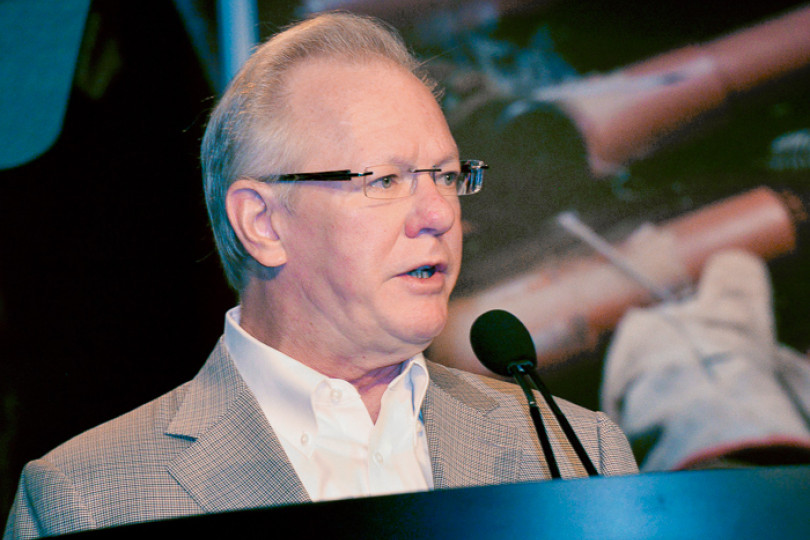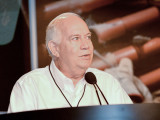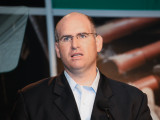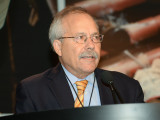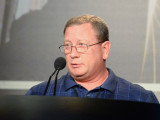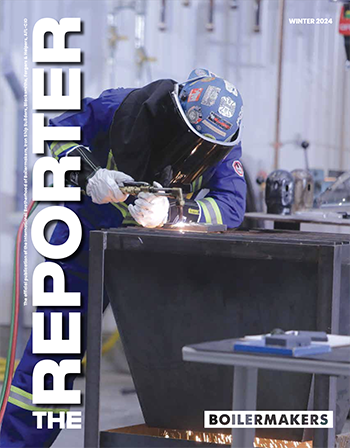IP Newton B. Jones calls for a more robust CCUS industry-government partnership.
View Photo Gallery (10 photos)
For a second year, group braves stormy weather
INDUSTRY PARTNERS ATTENDING the 31st National Tripartite Alliance conference in Myrtle Beach, South Carolina, October 3-5 kept a watchful eye on the approach of Hurricane Matthew but still managed to take in most of the event’s presentations and activities. The hurricane brought dire warnings up and down the U.S. East Coast, and Myrtle Beach faced a mandatory evacuation order for October 6. That led some participants to leave early, but many stayed through all the scheduled presentations.
It was the second time in two years that severe weather impacted the conference. In 2015, participants faced torrential rains and flooding. Despite the approaching hurricane, those in attendance were treated to excellent presentations from leaders in the utility and refining industries, the U.S. Senate, the U.S. Department of Energy, owners and contractors, and organized labor.
In his opening address, International President Newton B. Jones said all alliance partners seek the same things: to solve problems, create opportunities and advance their respective organizations. He added that carbon capture, use and storage is a vital solution for all partners and called for a more robust industry-government partnership “not only to constrain carbon emissions but also to preserve jobs and safeguard industry assets.”
Jones praised the advances being made using CCUS, citing four prominent projects in North America. They included, in Canada, the Sturgeon Refinery, an $8 billion project incorporating CCUS technology from the ground up; SaskPower’s Boundary Dam retrofit; and the Shell Quest project to install CCUS at its Scotford Upgrader. Jones also cited Southern Company’s new Kemper plant in Mississippi, which will generate electricity using coal gasification at commercial scale and capture carbon dioxide for enhanced oil recovery.
“It is exactly these kinds of projects that will create the breakthroughs we need to ensure reliable, clean-energy solutions for oil, gas and coal.” — Newton B. Jones, IP
New caucus format supports solution-based outcomes
CAUCUS BREAKOUTS, A staple of the National Tripartite Alliance, for the first time used live polling in the owner, contractor and union groups to determine the highest priority issues for alliance partners. Following the caucus breakouts, the NTA formed three working groups, each with owner, contractor and union participants. MOST Administrator Dale “Skipper” Branscum said the working groups will meet throughout the coming year and formulate recommendations on effective approaches to solving the issues facing alliance partners. Those recommendations will be central to the 2017 MOST National Tripartite Conference.
“Some of the feedback we get is that we address the same issues every year.” said Branscum. “Now we have a process that will accelerate and enhance our problem-solving efforts. This process will improve our understanding of the issues we face and help us tackle those issues more aggressively.”
Leading the breakouts were owner chair Jerry Payton, TVA; contractor chair David Zach, Nooter; and union chair Kyle Evenson, Boilermakers.
Working groups will address the following topics: adding human performance tools to the current MOST programs, especially safety training; addressing the skilled labor shortages, including welders; and expanding work opportunities outside of coal-fired power generation.
Polling results are available on the MOST website: www.mostprograms.com.
Speakers tackle industry challenges
TRIPARTITE AND GUEST speakers discussed the shifting energy industry and called for alliance partners to honor the tripartite approach when addressing issues.
John Erickson, Executive Director of the National Association of Construction Boilermaker Employers, urged alliance partners to collectively address future challenges, such as declining work opportunities in the utility industry. Erickson called for strategic planning at local and regional levels. “Solutions will not fall out of the sky into our laps, and solutions will not be “one size fits all,” he concluded.
R. Jake Locklear, President and CEO, AMP + APCom, and President of the Association of Union Constructors, stressed the need to come together to solve market challenges. He observed that coal is down, nuclear is stagnant, gas is cheap, and the cost of renewables is coming down and becoming more competitive. “The only way we’ll be successful is if we honor [the] tripartite approach and work together,” he said.
Locklear noted that competing in the marketplace is harder than ever, especially when nonunion craft workers are making gains. He said that giving customers dependable outcomes will demonstrate that Boilermakers are the safest, highest skilled and most dependable choice for their construction needs. He said one step in that direction is the Boilermaker Code. “I applaud the Code that makes the change to shift from an ‘us against them’ mentality. The Boilermaker Code is making a difference in the industry.”
“The Boilermaker Code is making a difference in the industry.”— R. Jake Locklear, AMP + APCom
Kim Greene, CEO of Southern Company, said the energy industry is in a tough situation, with federal and environmental regulations changing the way business is done, but working together can open up new opportunities. Citing Southern Company’s Kemper Plant in Mississippi, she said her firm is proud to be part of developing a technology that could “potentially, dramatically change the carbon footprint of this world.” She described coal as a low-cost, abundant resource that is also environmentally sound. “We can work together to find opportunities again for all of us to succeed going forward,” she said.
Department of Energy Senior Advisor David Foster called for a strong governmental research and development program and a tax policy to support CCUS development. “We need federal policies to share the risk being borne by the private sector,” he said. “With the right policies we can stabilize our coal communities and maintain energy diversity.” Foster noted that making the federal Section 45Q tax credit for CCUS permanent is a “very real proposition” that would help put people to work retrofitting power plants and meeting climate change goals.
“With the right policies we can stabilize our coal communities and maintain energy diversity.” — David Foster, DOE
Addressing the conference via Skype, Republican Senator Steve Daines from Montana said he was “shocked and devastated when the EPA went ahead with the [Clean Power Plan].” Daines noted that if these regulations are put into effect they will devastate Montana, costing 7,000 mostly union jobs, $145 million in tax revenue and $500 million a year in lost economic activity. Daines said clean energy should not be a partisan issue and that both parties need to be focused on jobs and a reliable source of energy.
In a video shown to conference participants, Ian MacGregor, Chairman of North West Upgrading, described the NWR Sturgeon Refinery near Edmonton, Alberta — an $8 billion project that incorporates CCUS into the overall design. Once phase one is complete at the end of 2017, the refinery will have the capacity to process approximately 79,000 barrels per day of bitumen-blend feed stock into approximately 80,000 barrels per day of high-value, high-demand refined products, according to MacGregor. He said there is a need for general education on this topic. “No one knows anything about it. They need to understand and know it can be done.”
Kingston Project hailed as tripartite success
FOUR SPEAKERS — TWO owner representatives, a contractor and a Boilermaker — reviewed the success of the Tennessee Valley Authority’s Kingston Project. In the spring of this year, TVA planned 56 projects across 10 planned outages. Bob Deacy, Senior Vice President at TVA, gave a brief overview of the corporation and then introduced Robert Bryan Williams, General Manager of Partner Alliance Support with TVA, to speak in detail about the Kingston Project. He said during the four months of work, there were zero safety incidents, zero environmental incidents and no clearance violations, workplace conduct issues, or quality issues. In addition, TVA met or beat every outage schedule, met their budget and maintained exceptional housekeeping.
Site lead for the Boilermakers, Jim Lindsey from Local 454 (Chattanooga, Tennessee), noted that safety was paramount at Kingston, even though it had not always been a primary focus in the past. Contractor and TVA management took responsibility to ensure that workers freely exercised their rights and responsibilities, and fully embraced the zero incident and injury principles.
Brian Barker, from G-UB-MK Constructors, praised the collaboration efforts, noting “This was a tremendous tripartite success story.” Barker said that the Boilermakers achieved a very significant reduction in the weld rejection rate from previous outages. “With the number of projects and the work performed, this was a landmark event in the history of the Kingston Plant,” he said.
MOST administrator highlights three programs
MOST ADMINISTRATOR DALE “Skipper” Branscum provided updates on three MOST programs: The Boilermaker Code, Leadership, and Substance Abuse. He said the Leadership Program is one of the most “under-utilized programs available through MOST, with some of the greatest value to all three of our tripartite partners.”
A recent enhancement to the Substance Abuse Program includes an E-screen option for obtaining an electronic chain of custody for the required annual drug test. Using email and a smartphone, a Boilermaker can obtain chain of custody within a few hours instead of waiting up to five days.
The Boilermaker Code has been in place for a year and has exceeded expectations, said Branscum. Since the program’s roll-out, 75 percent of all construction lodges have held at least one class, and a total of 2,110 Boilermakers have been trained. “That was more than anyone expected when we were here a year ago,” said Branscum, noting that feedback from owners and contractors has been overwhelmingly positive.
